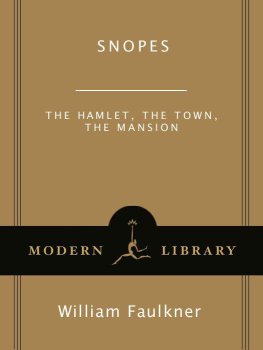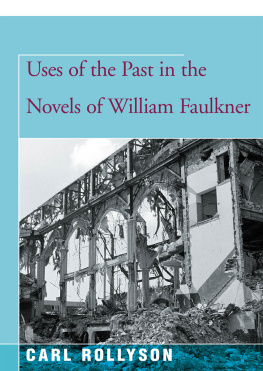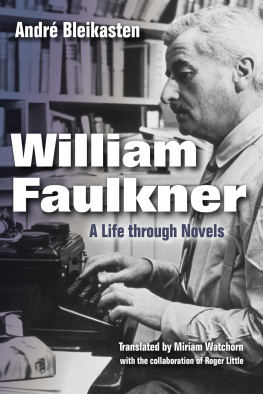Faulkner and Film
FAULKNER AND YOKNAPATAWPHA
2010
Faulkner and Film
FAULKNER AND YOKNAPATAWPHA, 2010
EDITED BY
PETER LURIE
AND
ANN J. ABADIE

www.upress.state.ms.us
The University Press of Mississippi is a member
of the Association of American University Presses.
Copyright 2014 by University Press of Mississippi
All rights reserved
Manufactured in the United States of America
First printing 2014

Library of Congress Cataloging-in-Publication Data
Faulkner and Yoknapatawpha Conference (37th : 2010 : University of Mississippi)
Faulkner and film / [compiled by] Peter Lurie and Ann J. Abadie.
pages cm. (Faulkner and Yoknapatawpha)
Includes bibliographical references and index.
ISBN 978-1-62846-101-5 (cloth : alk. paper) ISBN 978-1-62846-102-2 (ebook) 1. Faulkner, William, 18971962Film and video adaptationsCongresses. 2. American fiction20th centuryHistory and criticismCongresses. 3. Motion pictures and literatureCongresses. 4. American fictionFilm adaptationsCongresses. 5. Modernism (Literature)United StatesCongresses. I. Lurie, Peter, 1965 editor of compilation. II. Abadie, Ann J., editor of compilation. III. Title.
PS3511.A86Z7832113 2014
813.52DC23 2014008805
British Library Cataloging-in-Publication Data available
In Memoriam,
Betty Zachry Harrington
June 20, 1928October 22, 2011
Albert Murray
May 12, 1916August 18, 2013
Stephen M. Ross
November 28, 1943August 21, 2013
Louis D. Rubin
November 19, 1923November 16, 2013
Dr. Chester Andrew McLarty Jr.
December 9, 1916November 23, 2013
Introduction
The most arresting moment in Absalom, Absalom!, literally and figuratively, is when Clytie blocks Rosa Coldfield on the Sutpens Hundred stairs. The moment is unique in the novel for several reasons, standing as it does as one of its few instances of actual physical contact, but also for the significance to Rosa of its interracial aspect. Moreover it encompasses a broad thematic concern at the heart of the novelindeed, in all of Faulkners South. Such a touching as Clyties is clearly an affront, and Rosas outraged responseTake your hand off me, nigger!states openly thoughts that characters like Sutpen, Henry, and even Quentin harbor toward black-white somatic relations, but never utter.
The moment on the stairs is significant for what it points up about the meanings of touch to the novel and its characters, as well as in experience generally. In terms that are apposite to Rosa and Clyties encounter, Jennifer M. Barker states, Tactility is a mode of perception and expression wherein all parts of the body commit themselves to, or are drawn into, a relationship with the world that is at once a mutual and intimate relation of contact. The... contact between touching and touched and the relationship of mutual, reciprocal significance that exists between them, she continues, are universal structures. We should immediately ask that Barkers insistence on the universal quality of touching and structures of intimacy yield to the highly charged historical and racial character of Rosas and Clyties encounter. For, as we know, Clyties touch and Rosas reply occur within the double register of their antebellum, plantation history and Quentins Jim Crow context of 1910, in which the incident is recalled. Nevertheless, Barkers account of the importance of touch, its unique power to unsettle or discomfit, has particular relevance to this scene.
Barker offers her observations, not in the context of Faulkner scholarship, nor even literary studies generally, but in her book The Tactile Eye: Touch and the Cinematic Experience. Yet her approach to film is of interest to the passage describing Clytie and Rosa, both for the ways their encounter may be seen to resemble cinema and for its resonance with film aesthetics and history. For it is also the case that this noteworthy intimacy recalls a signal moment in film history that bespoke As in Griffiths film, the black and white moment of Rosa and Clytie on the stairs stands out, rising into relief against the books recollected action in a moment that ruptures the surface of the novels rich but obfuscating prose. Viewed such, this passage may be said to possess its own haptic, if not also cinematic quality within our reading that follows the felt description of black on white skin.
Other events in the novel figure similarly. We might think of Henry and Judith exchanging words like slaps, as if they stood breast to breast striking one another in turn after Henry kills Bon (143), or of the staccato effect of what Bon shows Henry in New Orleans and its indexical, physical mark on the innocent and negative photographic plate of Henrys provincial soul (91, 92), or of Quentin striving to read the lettering on Sutpens tombstone with his fingers in the half-light of the cedar grove (158), or of the rectangular shape of his fathers letter resolving itself physically on the surface, first, of Quentins eyes, then, and only slowly, on his understanding: he would be able to decipher the words soon, in a moment; even almost now, now, now (309). If we consider the writing in the novelas well as of the novelto operate as an example of proprioceptive stimuli to the body and the nerves as well as to cognition, we might see how Rosas demand to Clytie expresses a fact that is notable within both the books workings and its events.
Such writerly touching may be unique to Faulkner. It is, however, a quality that is readily attributed to film, as Barker and others suggest.Clyties touch on the stairs is only one example of the arresting quality of Faulkners writing more generally, manifest in its idiosyncratic syntax, diction, and punctuation throughout Absalom, as elsewhere.
It will thus come as little surprise that Faulkner has often been called the most cinematic of novelistsa statement that may mean many things, but which also begs several questions. Among other interests is the matter of whether all modernif not also Modernistliterature is to some extent mediated or shaped by motion pictures and whether there is any sense to asserting which writers are any more or less in league with the visual technology of film. The assumption that any early twentieth-century writer, Faulkner included, was influenced by film is far from new; nor is it a novel insight that such influence may bear on our understanding of modernism generally, which has seen its purview opened to the realms of popular art and discourse, perhaps above all that of the cinema. The matter of what cinematic itself means is deceptive, despite common assumptions about what the term conveys generally or in this context. The significance of film to Faulkner himself as well as to understanding his fiction is a question on which the essays in this volume dilate variously, and to which they respond to penetrating effect.
Critical discourse has long been fascinated with these questions, and for a number of reasons. Beginning with Bruce Kawins genuinely orienting work on Faulkner and film, both for the 1979 Faulkner and Yoknapatawpha volume and in his book of the same title, Faulkners connections to mass and visual culture have been deepened considerably. This move began in earnest with Joseph Urgos 1990 Absalom, Absalom!: The Movie, followed by M. J. Burgesss 1991 Watching Jefferson Watching: Light in August and the Aestheticization of Gender, which also reads Dry September closely through movies and moviegoing (each of these followed Gene Phillipss 1988
Next page







